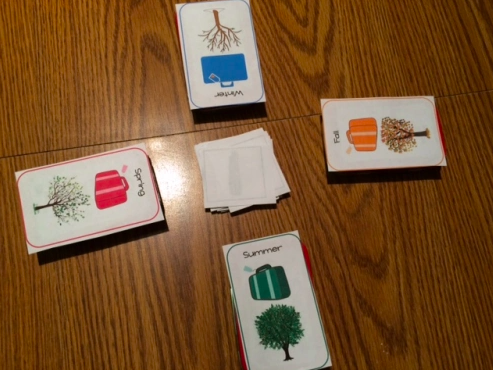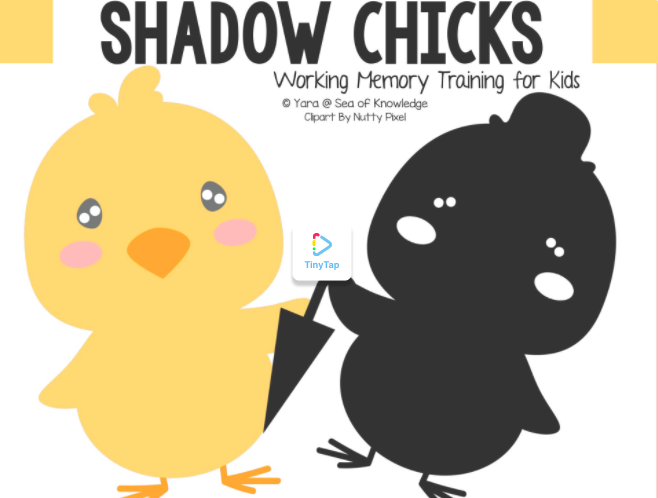Working memory refers to the ability to hold small amounts of material in mind while completing a related task. In other words, it plays a vital role in keeping us from being just like a goldfish! When your learners are struggling to follow verbal instructions or complete a two-part task, you may need to step in and boost this ‘mental notepad’ of theirs. To help you do just that, we’ve sourced an array of activities ranging from classic memory games to sequencing activities and more! Keep scrolling to discover a few helpful resources to help your kiddos boost their memory functioning
1. Suitcase Send-off

This is a fun and imaginative game for your little ones to enjoy. Get them to think about both the season they’ll be traveling in and the clothing they’ll need for said trip. Playing in groups of 2-4, each kiddo must pack a suitcase with certain pieces of clothing based on one of the 4 seasons. How does this incorporate memory you ask? They’ll need to remember what clothing items they’ve packed in order to detail their suitcases’ contents to their group.
Learn more: Jill Kuzma
2. Shadow Patterns

If you’re looking for some interactive memory fun that will keep your littles engaged and motivated, this is just the activity! Show them a video where they’ll be prompted to identify the shadow that most closely resembles the image that they would’ve just seen before.
Learn more: Tiny Tap
3. Memorize The Constellations
Here’s a tool that’s easy to use and has been specifically designed to boost your kiddos’ working memory. Simply have your learners memorize a display of constellations before flipping to the next slide and inputting the same pattern on a blank grid.
Learn More: Neuron Up
4. Number, Color, Shape Blink Test
Help your littles boost their working memory with a few exciting card games! If you have a deck of shaped-based playing cards on hand then you can follow the simple instructions to have your kiddos play 3 different games using them. Get your class on deck for this fun activity!
Learn More: Memory Improvement Tips
5. Neuroscience for Kids
Get your learners to take the test to discover how good their short-term memory is. This site includes a baseline test and provides an excellent collection of strategies to help you support your pupils’ memory development.
Learn More: Washington Faculty
6. Memory Matching Card Game
Here’s a classic memory game that we guarantee your littles will love! Place pictures, words, or a combination of the two on pairs of cards. Then, flip over the cards, mix them up, and get your kiddos to flex their mental muscles to find the matching pairs. To keep your students engaged, start with fewer pairs as they’re learning to play. Watch their memory abilities grow in no time!
Learn More: The Many Little Joys
7. Letters in Places
Boost letter recognition, listening skills, and memory with one lively game! Call out a letter and then have your students scurry around to find objects in the room that start with that sound. They’ll sharpen their short-term memory as they link sounds with their surroundings.
Learn More: The Toolbox
8. Rhythm Echo
Clap, clap, snap! Did you know that echoes can help build memory? Clap out short rhythmic patterns for your musically-inclined students to listen closely to and echo back. Increase the complexity of your catchy beat sequences as their auditory short-term memory improves.
Learn More: Magical Movement Company Carolyn’s Blog
9. Physical Mnemonics
Bring concepts to life through movement-based memory aids! Have your students link spelling words, test facts, or math formulas with fun physical movements. We like to call these ‘Body Pegs’: a tool where you help your kiddos link each word or concept to a specific body part and action, like a finger click or belly rub. These dynamic mnemonics will boost retention and recall in an engaging way and are especially useful to your kinesthetic learners.
Learn More: Memory Improvement Tips
10. Number Balancing
Strengthen memory muscles with this body and brain game! Get your students to memorize a number or small sequence of information before completing an exercise like jumping jacks. Then, have them recite what they learned beforehand. Up the ante and challenge by increasing the information that they need to remember.
Learn More: Smitten With First Blog
11. Memory Draw
It’s not what you look at that matters, it’s what you see! Show your kiddos an interesting drawing and have them study it. Then, provide your detail-oriented doodlers with a blank page and challenge them to re-create the images whilst relying on their visual memory!
Learn More: YouTube
12. What’s Missing
Find out who your super sleuths are with this observation game! Place categorized objects on a tray and give your littles a chance to study them. Then, without them seeing, remove one item. Reveal the tray again and see if your budding detectives can identify what’s missing.
Learn More: Twinkl
13. Story Retellings
This sequencing challenge is great for boosting working memory and encouraging higher-order thinking. After reading or listening to an engaging story, have your students recount the details from the narrative in the correct order. Simply ask them to write, draw, list, or repeat what they can recall. Their memory retention is sure to grow leaps and bounds with each literary adventure!
Learn More: Issuu
14. Board Game Replay
Put a fun twist on regular board games to tie in some working memory development! Select multiplayer board games, like Checkers, Backgammon, or Chess, and pair your students up. Then, have one player observe while the other plays a round. This is when the real challenge begins. Have the players then switch places and task the previous observer with trying to recreate all the strategic moves from memory.
Learn More: Dad Suggests
15. Song Lyrics
This one’s for all the music fanatics in your class! See if your littles can memorize and perform their favorite song lyrics to develop auditory memory networks. The enjoyment of this activity is sure to make memorization feel like a breeze!
Learn More: Elf Learning
16. Follow the Leader Routines
This activity is essentially a conga line with a twist! Have one student lead the class in performing an action and then challenge the rest of your learners to repeat the exact sequence. As routines get longer, visual and spatial memory is sure to increase. Up the challenge by switching leaders!
Learn More: ABCs of Movement
17. Science/History Timelines
Recapping and remembering dates of old isn’t easy- especially when there are other subjects that our students need to focus on! Test their memory by having them recreate timelines of different historical events from memory. This activity strengthens memorization, sequencing abilities, and comprehension- and makes for a great task to aid them in prepping for any upcoming tests.
Learn More: Twinkl
18. Map My Way
This activity involves using maps, whether they are of a city, a country, or a fictional place, to help your kiddos develop their memory retention. Begin by having a group of learners study the map for a set period of time. Once the time is up, remove the map and ask questions like “What was the third city on the river?” or “Which mountain was to the East of the forest?”. Over time, introduce more detailed maps to increase the challenge that much more.
Learn More: Education
19. Recall the Recipe
For this activity, share a simple recipe with your learners. Be sure to take a few moments to go over the ingredient list and basic steps together. After a brief period, ask your kiddos to recall as many ingredients as they can before describing the steps of the cooking process.
Learn More: Dr.Monique Tello
20. Listen and Draw
Here’s an excellent activity if you’re keen on having your students develop their active listening skills. Simply play an audio clip or read a short descriptive passage aloud. Then, ask your pupils to draw a scene that corresponds with what they heard. This activity will challenge their auditory working memory as well as their ability to recall specific details from a spoken source.
Learn More: TPT
21. Action Sequence Challenge
Here’s a fun memory activity that can be enjoyed outdoors. Think up a sequence of physical actions such as “jump, turn around, clap twice”. Complete the actions before challenging your little ones to replicate it. As they get the hang of things, add more actions to the series or introduce multi-step instructions, such as “jump while clapping” to further test their working memory.
Learn More: Empowered Parents
22. Pattern Beads
Make memory learning a tactile adventure by employing this next strategy! Equip your learners with beads of different colors. Next, create a specific color pattern with the beads and have your class study it. Lastly, invite them to put their memory to the test by seeing if they can recreate the exact same sequence.
Learn More: U Create Crafts